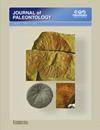北阿拉伯地台坎帕纪(晚白垩世)异支亚属Trochactaeon及其古环境和古生物地理意义
IF 1.6
4区 地球科学
Q3 PALEONTOLOGY
引用次数: 0
摘要
在特提斯王国的晚白垩世生物群中,微孔螈是最重要的海洋大型无脊椎动物类群之一。它们是与白垩纪碳酸盐岩台地群落相关的常见动物元素,最显著的是它们丰富的粗糙框架,并在同时期的泻湖中茁壮成长。位于土耳其东南部的上白垩纪卡拉巴巴组(Karababa Formation)中,发现了一组引人注目的软腹足类动物和粗足类动物。在过去的80年里,土耳其沉积序列中的白垩纪腹足类动物几乎没有被研究过。Trochactaeon亚属是一种分布广泛的异支腹足动物,在晚白垩世占据主导地位。本文首次报道了土耳其巨兽(Trochactaeon)亚球形巨兽(giganteus subglobosus)。它来自Gölbaşı地区(Adıyaman以南)卡拉巴巴组上部的单一坎帕尼亚下层,对应于阿拉伯地台的西北部。这一记录补充了白垩纪晚期特提斯洋南缘特恰克泰翁的时空分布信息。这一发现增加了土耳其东南部上白垩纪演替古动物的多样性,并为了解阿拉伯北部板块碳酸盐斜坡的古环境以及坎帕尼亚腹足类动物的古生物地理提供了新的见解。本文章由计算机程序翻译,如有差异,请以英文原文为准。
The heterobranch subgenus Trochactaeon (Trochactaeon) in the Campanian (Late Cretaceous) of the northern Arabian Platform and its paleoenvironmental and paleobiogeographic implications
Acteonellids were one of the most significant groups of marine macro-invertebrates in the Late Cretaceous biota of the Tethyan Realm. They were common faunal elements associated with Cretaceous carbonate platform communities most notable for their abundance of rudist frameworks and thrived in coeval lagoons. The Upper Cretaceous fossil-bearing Karababa Formation, cropping out in southeastern Turkey, yields a remarkable assemblage of acteonellid gastropods and rudists. Cretaceous gastropods from sedimentary successions in Turkey barely have been studied over the past 80 years. The subgenus Trochactaeon, a very successful and widespread taxon of heterobranch gastropods within the family Acteonellidae, dominated acteonellid assemblages throughout the Late Cretaceous. In the present work, we present the first record of Trochactaeon (Trochactaeon) giganteus subglobosus from Turkey. It is from a single lower Campanian bed in the upper part of the Karababa Formation of the Gölbaşı region (south of Adıyaman), corresponding to the northwestern part of the Arabian Platform. This record complements information on the temporal and spatial distribution of Trochactaeon at the southern margin of the Tethyan Ocean during the last part of the Cretaceous Period. This discovery increases the documented diversity of the paleofauna from the Upper Cretaceous succession in southeastern Turkey and provides new insights into the paleoenvironment of the carbonate ramp of the northern Arabian plate, and the paleobiogeography of Campanian gastropods in general.
求助全文
通过发布文献求助,成功后即可免费获取论文全文。
去求助
来源期刊

Journal of Paleontology
地学-古生物学
CiteScore
2.80
自引率
7.10%
发文量
94
审稿时长
6-12 weeks
期刊介绍:
The Journal of Paleontology publishes original articles and notes on the systematics, phylogeny, paleoecology, paleogeography, and evolution of fossil organisms. It emphasizes specimen-based research and features high quality illustrations. All taxonomic groups are treated, including invertebrates, microfossils, plants, vertebrates, and ichnofossils.
 求助内容:
求助内容: 应助结果提醒方式:
应助结果提醒方式:


